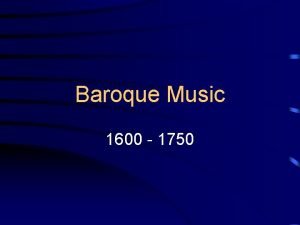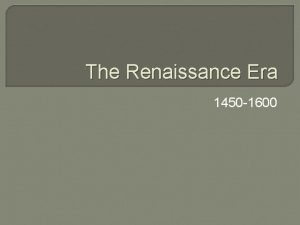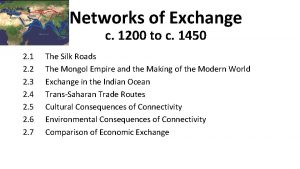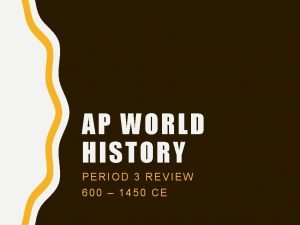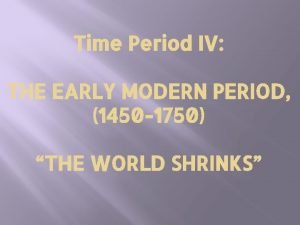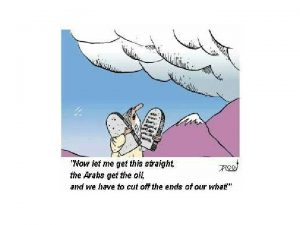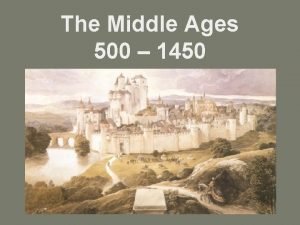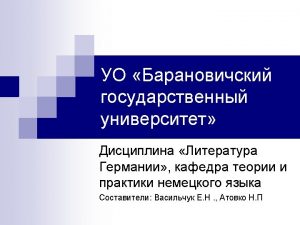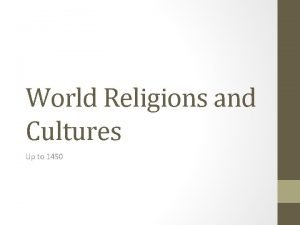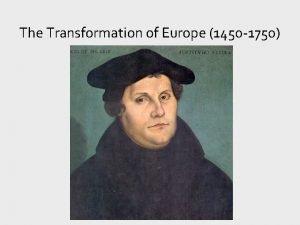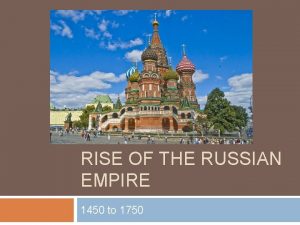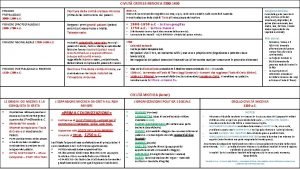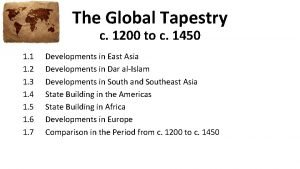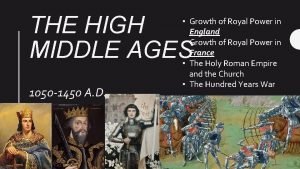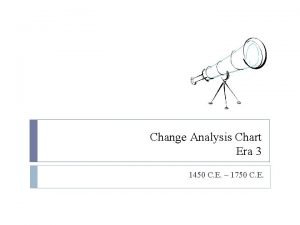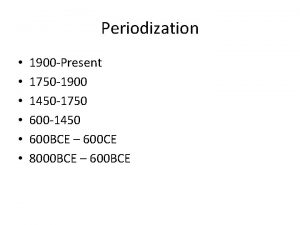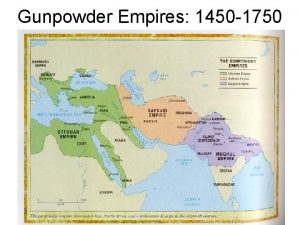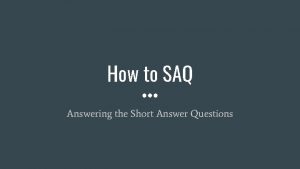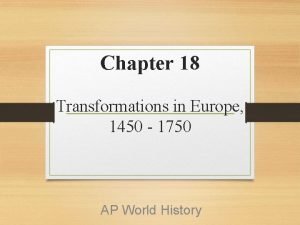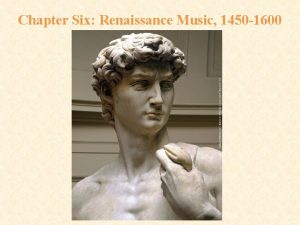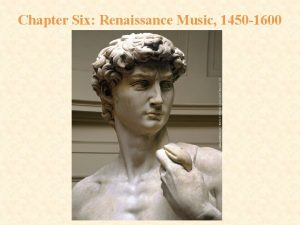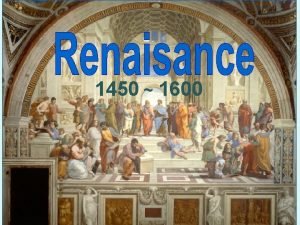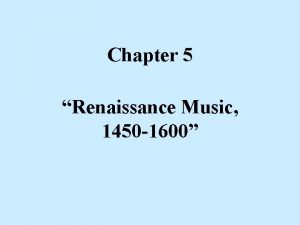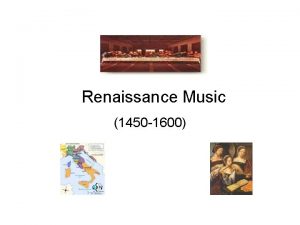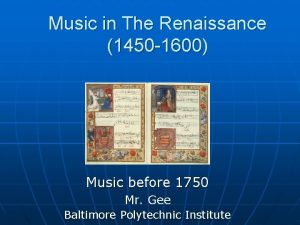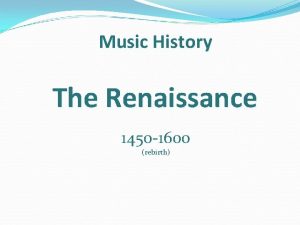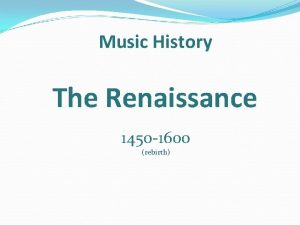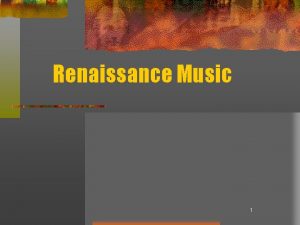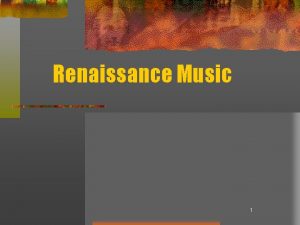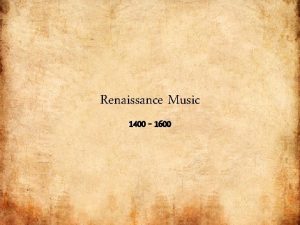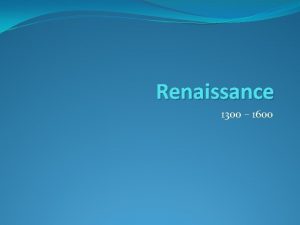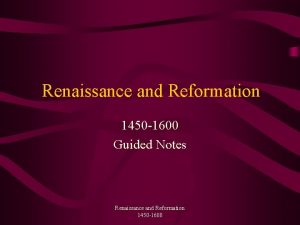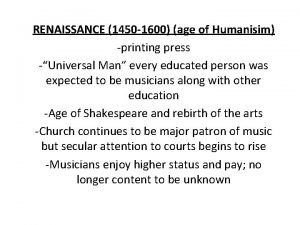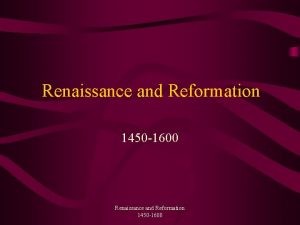Music of the Renaissance 1450 1600 Renaissance means





















![ANTONIO VIVALDI First Movement: Allegro from La Primavera [Spring], Concerto for Violin and String ANTONIO VIVALDI First Movement: Allegro from La Primavera [Spring], Concerto for Violin and String](https://slidetodoc.com/presentation_image_h/a9c5e5c69af894e7642c023e013d85a8/image-22.jpg)









- Slides: 31

Music of the Renaissance (1450 -1600)

Renaissance means “Rebirth”

New scientific & geographical exploration n Copernicus n Columbus n Magellan

Power Shift n “The” Church (Catholic Church) loses some power to secular governments (Nobility of court system - Kings, Queens, etc. ) – Still important patron of the arts – Authority challenged • Martin Luther (1483 -1546)

HUMANISM n New intellectual movement n Focused on human accomplishments n Rediscovery of Greek and Roman books and culture via the Middle East

Resulting Changes in Artists make art that has to do everyday HUMAN feelings n Artists look back to Greek and Roman Art n – Ancient Greek and Roman music had a “RHETORICAL” quality • Meant to represent a feeling or idea – Ancient Greek and Roman visual art was about mythological subjects or real people of nobility; these people were represented in a life-like manner with an emphasis on sensuality of HUMAN body

How did Renaissance composers write more rhetorical music? More “life-like” text rhythms n Word Painting n 1. Literal or mimetic correspondences example: “alone” 2. Figurative or symbolic depiction (punning & double meanings) example: “high on the mountaintop” 3. Emotional connotations example: (chromaticism) on “pain and sorrow”

Word Painting n Musical representation of specific images - for example, a falling melodic line ot accompany the word descending - often found in Renaissance and Baroque music

THOMAS WEELKES (c. 1575 -1623) As Vesta Was from Latmos Hill Descending n madrigal genre n a cappella vocal composition n text is a sonnet (Renaissance poem) in the vernacular (English) n sung 1 on a part in intimate setting n includes both imitative polyphony and homophony n lots of examples of text painting

Madrigal n Composition for several voices set to a short secular poem, usually about love, combining homophonic and polyphonic textures and often using word painting; common in Renaissance music

A cappella (literally means“of the church” in Latin, but can refer to both sacred and secular music) n Choral music without instrumental accompaniment

As Vesta was from Latmos hill descendin She spied a maiden Queen the same as Attended on by all the shepherds’swain; To whom Diana’s darlings came running down amain First two by two, then three by three tog Leaving their Goddess all alone, hasted And mingling with the shepherds of her t With mirthful tunes her presence did ente Then sang the shepherds and nymphs o Long live fair Oriana!

JOHN WARD (English Renaissance Madrigalist) n Upon a bank with roses set about

Upon a bank with roses set about, Where pretty turtles joining bill to bill And gentle springs steal softly murmuring out, Washing the foot of pleasure’s sacred hill, There little Love sore wounded lies,

JOHN FARMER (English Renaissance Madrigalist) n Fair Phyllis

Fair Phyllis I saw sitting all alone Feeding her flock near to the mountain side. The shepherds knew not wither she had gone, But after [her], her lover Amyntas Up and down he wandered while she was missing; When he found her, oh, then they fell a-kissing.

JOSQUIN DESPREZ (c. 1440 -1521) n Two types of SACRED Renaissance music GENRES – MASS – MOTET n SACRED Renaissance music DOES NOT use Text Painting – Emphasis is on musical structure and religious “otherworldly” musical qualities

Motet n Polyphonic choral work set to a sacred Latin text other than that of the mass; one of the two main forms of sacred Renaissance music


Musical Rhetoric • Refers to the emotive (causing a listener to feel a specific way) or persuasive (causing the listener to "see" a scene or "hear" a story) power of music • An example of musical rhetoric is the way a composer tries to "paint" a picture of a scene, story, or idea in the listener's mind of a written text, which is either sung or given to the listener in the form of a program.

FRANZ SCHUBERT Erlköing (The Elfking) n Lied (leet) / Lieder (leader) – An art song with a German text
![ANTONIO VIVALDI First Movement Allegro from La Primavera Spring Concerto for Violin and String ANTONIO VIVALDI First Movement: Allegro from La Primavera [Spring], Concerto for Violin and String](https://slidetodoc.com/presentation_image_h/a9c5e5c69af894e7642c023e013d85a8/image-22.jpg)
ANTONIO VIVALDI First Movement: Allegro from La Primavera [Spring], Concerto for Violin and String Orchestra, Op. 8, No. 1 from The Four Seasons

Spring has come, and joyfully, The birds greet it with a happy song. And the streams, fanned by gentle breezes, Flow along with a sweet murmur. Covering the sky with a black cloak, Thunder and lightning come to announce the season. When these have quieted down, the little birds Return to their enchanting song.

Leonardo da Vinci (1452 -1519) Painter, sculptor, architect, engineer, & scientist n A “Renaissance” Man n – Emphasis on education n Mona Lisa – Real person

Botticelli (1445 -1510) n The Birth of Venus (1485) – Mythological deity – Emphasis on reality & sensuality of human body n La Primavera (147778) – Mix of real people & mythological characters – Depiction of everyday HUMAN emotions



Michelangelo (1475 -1564) n David (1504) – Biblical character – Real person – Emphasis on reality & sensuality of human body

Raphael (1483 -1520) n Aristotle and Plato (1511) – Greek and Roman influence – Real persons n The School of Athens (1511) – Greek and Roman influence – Emphasis on reality with use of perspective


William Shakespeare (1564 -1616) n Playwright who writes about real and mythological persons – Example: Romeo & Juliet • Focuses on everyday HUMAN feelings
 Historical events in the renaissance
Historical events in the renaissance Online music portfolio
Online music portfolio Mood of baroque music
Mood of baroque music The period in music from 1452 1600
The period in music from 1452 1600 Time of rebirth
Time of rebirth Music intervals in ilocano music is
Music intervals in ilocano music is Enumerate the vocal music of the romantic period
Enumerate the vocal music of the romantic period Rhythm music appreciation
Rhythm music appreciation A music that employs electronic musical instruments
A music that employs electronic musical instruments 1450 am st george
1450 am st george Adopalen
Adopalen Period 3 ap world history
Period 3 ap world history Splitski nadbiskup 1450
Splitski nadbiskup 1450 Aegean art
Aegean art World map 1450
World map 1450 Fur trade ap world history
Fur trade ap world history 1250 bc
1250 bc 500/1450
500/1450 Mughal empire 1450 to 1750
Mughal empire 1450 to 1750 Historischer hintergrund naturalismus
Historischer hintergrund naturalismus Religion 1450-1750
Religion 1450-1750 Europe 1450
Europe 1450 Russian empire innovations 1450 to 1750
Russian empire innovations 1450 to 1750 Prepalaziale
Prepalaziale Global tapestry
Global tapestry Southeast asia 1450 to 1750
Southeast asia 1450 to 1750 1450 ad
1450 ad Change analysis chart 1450 to 1750
Change analysis chart 1450 to 1750 1750/600
1750/600 Land based empires 1450 to 1750
Land based empires 1450 to 1750 Cultural exchange between nomads and non nomads before 1450
Cultural exchange between nomads and non nomads before 1450 Europe 1450
Europe 1450


